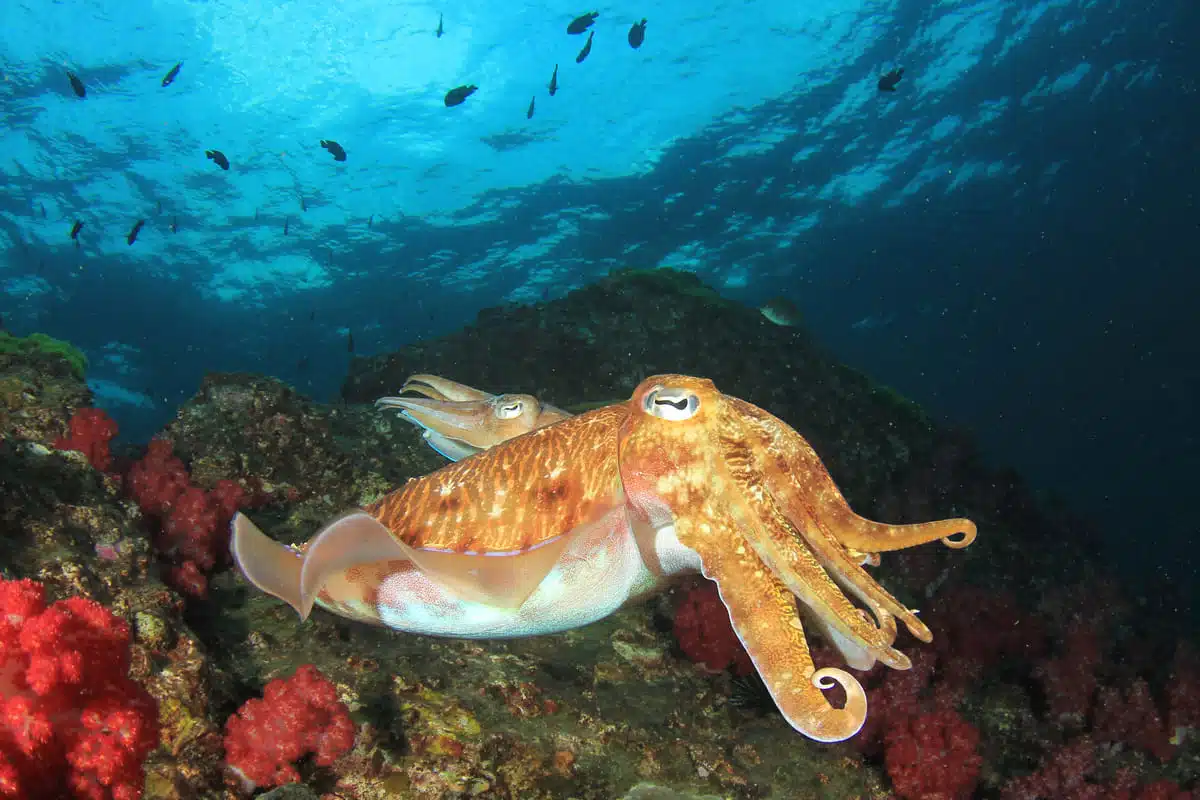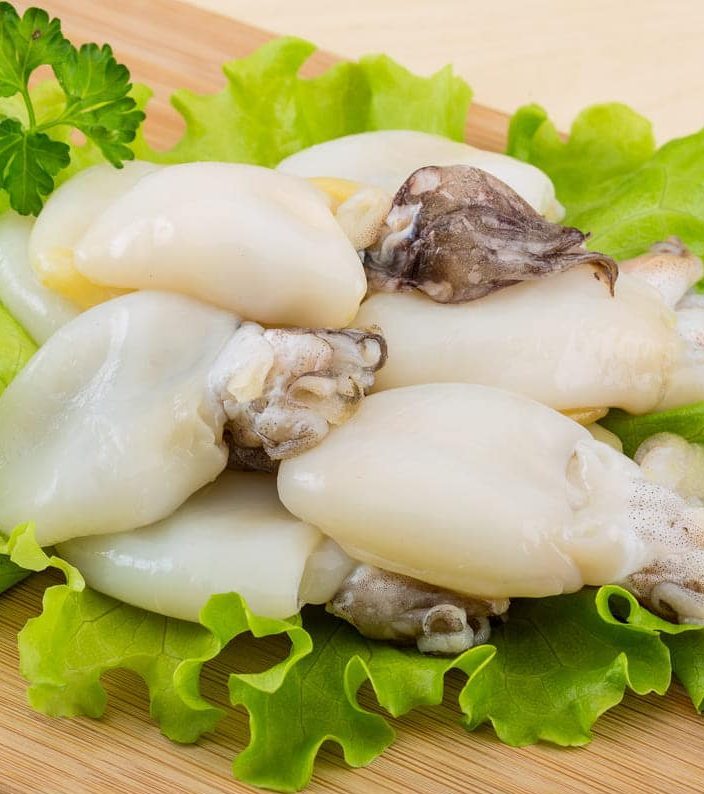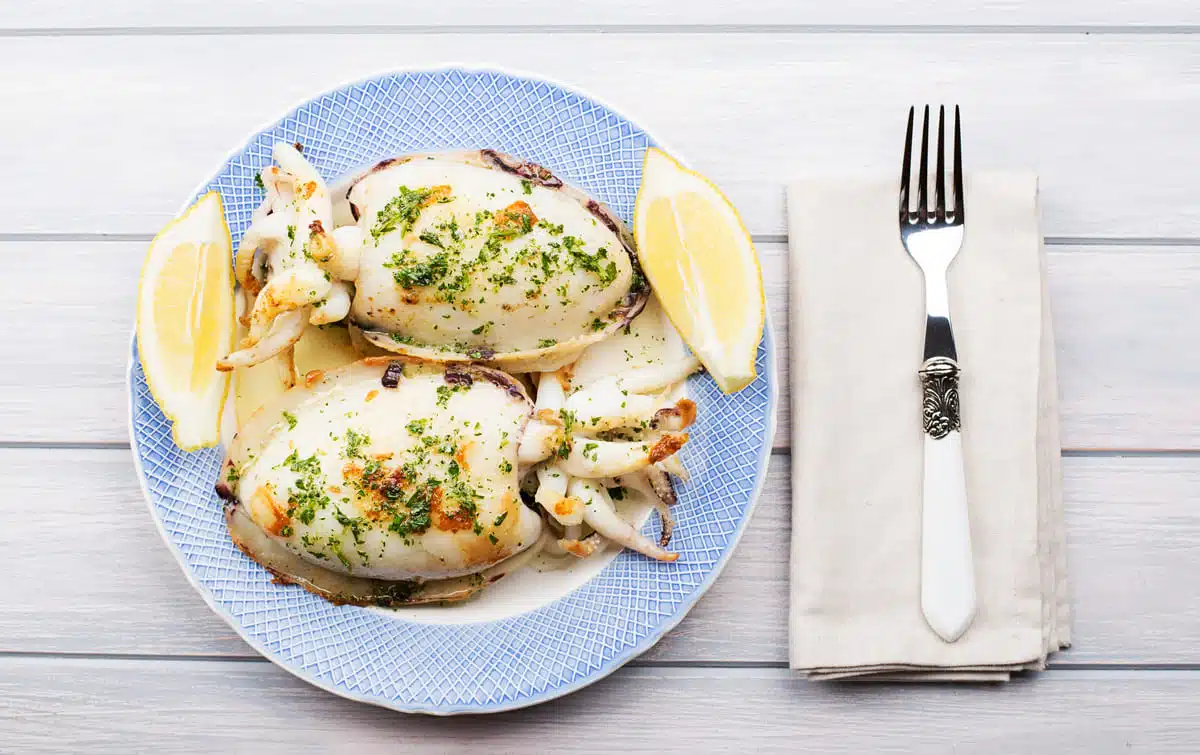
Introduction
There is much less known about cuttlefish than octopuses and squids, their closest relatives. Despite their diminutive size compared to giant squids and less well-known than octopuses, these vibrant, multiarmed cephalopods deserve greater attention.
What is Cuttlefish?
Despite the name, cuttlefish are not fish. The cuttlefish (Sepia officinalis) is a species of mollusc found along coastal waters throughout Australia, Asia, Europe, and Africa.
There are over 120 species of female and male cuttlefish exist. Their habitat is the sea floor, which is why they are called bottom dwellers. Most often, they are found in southern England and Ireland, although they can sometimes be found further north.
In general, brightly flamboyant cuttlefish have broad bodies that are flanked by two fins. Observing a broad club cuttlefish’s tail up close reveals that the fins are not connected.
There are two eyes on either side of the broad head of the vibrant cuttlefish. Each eye has a distinct W-shaped pupil. Each arm consists of several suckers. There are eight arms in total.
A gas-filled chamber floats their body in their cuttlebone, their distinctive internal shell. The cuttlebone of this animal is used as a calcium supplement.
There is nothing like cuttlefish. When threatened, they shoot black ink out of their two tentacles. Their ink can create a body double, conceal themselves, and deceive their attackers.
A related species of both octopus and squid, it also goes by the name of ink fish. It has a similar taste to octopus. People eat cuttlefish, and the tentacle ink has a distinct seaweed flavour and colour. A source of natural colour and flavour in dishes such as pasta and risotto, or as an ink source, it has many uses.
Types of Cuttlefish
Common Cuttlefish (Sepia officinalis)
It is a cuttlefish native to Northern Africa and Europe. Molluscs of this species grow up to 19 inches and 8 pounds in length and weight, though they are usually comparatively smaller outside of tropical waters. They are found in the Mediterranean Sea, the North Sea, and the Baltic Sea. There have been reports of this species in western Africa and south of the continent. Currently, Tunisia counts this cuttlefish as one of its most valuable seasonal catches.
Kisslip Cuttlefish (Sepia lycidas)
It’s an Indo Pacific Cuttlefish, but its range is somewhat limited compared to other cuttlefish types. The main areas where it is prevalent are Burma, Indonesia, and Japan. This species is known for its dramatic colour changes, particularly its vibrant greens and blues. It grows to a maximum size of 15 inches and weighs 11 pounds.
Pharaoh Cuttlefish (Sepia pharaonis)
A 16-1/2-inch mantle (body) and 11 pounds of weight are typical sizes for these western Indo-Pacific species. Northern and southern Indian Oceans, Australia and the Philippines are substantial fishing grounds for them. There is a 90% capture rate of this species in Australia. In terms of density, they are nice and meaty. Their range extends westward from the Red Sea to the Persian Gulf, extending into the Mediterranean Sea.
Seafood processing: Cuttlefish
As with other cephalopods, cuttlefish meat is deliciously tender. Tender and savoury, it is edible raw but is typically cooked. A typical side dish of Asian cuisine is frequently eaten as a side dish. Cuttlefish taste sweet and have a smooth texture.
Whole Cuttlefish
Dinner parties can be spiced up with this excellent choice.
Cuttlefish whole grilled on a barbecue will hold a smoky flavour and beautiful grill marks, making it an ideal alfresco meal.
It’s delicious to cut cuttlefish thin and tempura batter it; however, the tentacles need to cook longer. Cooking stews with tentacles is a good idea.
Cuttlefish fillet meat
A cuttlefish fillet contains little fat and cholesterol and has a delicate taste. Meat has a firm texture and a slightly salty aftertaste. Various ways can be used to prepare cuttlefish fillets. If you’re looking for a yummy and healthy meal, bake it with garlic and lemon.
Cuttlefish tentacle
Sushi and seafood subproducts can be made with it. Japanese cuisine uses tentacles to top ramen and noodles. Garlic, red onion, wine, and balsamic vinegar are good additions to a casserole of cuttlefish tentacles.
Cuttlebone
It is the former external shell of the cuttlefish. Over a large portion of the body cavity, it forms a roof that covers it. A shortcut can be cut at the front of the mantle and squeezed out to remove it. It is loosely attached, with only skin surrounding it.
The cuttlefish’s body is stiffened by this component, which controls buoyancy. Historically, it was used as an antacid and toothpaste for centuries, but now it primarily supplies calcium to captive birds. As a moulding material, goldsmiths continue to use it.
Cephalopod ink
In the past, this has been used as an ink for writing instruments. The ink from cuttlefish is brown, hence the Greek name for cuttlefish and its genus, Sepia.
Is Cuttlefish a good tasting fish?
There isn’t much difference between an octopus and a squid, so you should have no problem eating cuttlefish. When compared to squid, cuttlefish have better flavour.
The texture and taste of fresh, uncooked cuttlefish are superior to squids. It has a delicate sweet smell, a soft texture, and a smooth milky flavour, beautifully raw, yet able to stand up to crispy pepper-salt combinations.
Benefits of Cuttlefish
It is well known that a variety of essential vitamins and minerals can be found in high concentrations in these creatures, so they are nutritious when eaten only in moderation. Here are a few advantages:
Maintain a healthy heart
Despite their lack of fat, cuttlefish contain unsaturated fatty acids such as DHA and EPA. Diets rich in omega-3 fatty acids reduce the risk of heart attacks by lowering triglycerides, decreasing blood pressure, and inhibiting clotting, which prevents arterial clogging.
Homoeopathic use of cuttlefish ink
In the same way as squids and octopuses, cuttlefish release ink and avoid danger from predators. Symptoms of menstrual problems, skin problems, and anxiety have been treated with this ink in homoeopathic medicine for thousands of years.
A pill or tablet containing cuttlefish ink or sepia is available. By diluting the ink with sugar water, laboratories prepare a tincture using cuttlefish ink derived from internal glands. Adding other plant ingredients to this tincture makes a homoeopathic formulation.
According to some people, the ink alleviates irritation and enhances mood. Some physicians prescribe tinctures to address reproductive issues, such as fatigue and libido loss.

Using cuttlebones
A cuttlefish’s cuttlebone is made of aragonite and is hard and porous. Cuttlefish have this unique structure, distinguishing them from their relatives, such as squids and octopuses.
Jewellery makers use it to make cast moulds. Parakeets and similar birds are also given cuttlebones as supplemental food. Its coarse texture helps these birds wear down their long beaks.
Traditional Chinese medicine has used cuttlebone for various ailments, most notably asthma, bleeding and ulcerations, gastric ulceration and duodenal ulceration.
Dentists use it to stop bleeding after teeth are pulled. In addition to balancing stomach acid, lowering pepsin levels, and modifying the pH of your intestines, cuttlebone aids in ulcer healing. According to animal studies, cuttlebone may help restore bone health.
Nutritional profile
Nutrients per Serving
Unsaturated fats in cuttlefish, particularly omega–fatty acids such as EPA and DHA, reduce heart disease risk by lowering blood pressure, reducing triglycerides, and protecting arteries against blockages.
Many vitamins can be found in cuttlefish. Vitamins such as A, C, riboflavin, niacin, folate, B6, and B12 are present in them.
Moreover, it contains high magnesium, calcium, iron, phosphorus, sodium, potassium, zinc, manganese, selenium, and copper. Mercury and cadmium are most likely present in cuttlefish, so it is advisable to consume them only occasionally.
What to look for when buying Cuttlefish?
Buy cuttlefish whole if their flesh has a little transparency and their skin has reflective patches. If there is any sand on the flesh, clean it with cold water. The flesh should feel stable and elastic rather than greasy or coarse.
Storing Cuttlefish
Cuttlefish and other cephalopods are excellent at freezing. Because their flesh is dense and uniform, crystallisation doesn’t affect the texture.
Store your cuttlefish on an ice bed or in the coldest part of your refrigerator after purchasing them. It is recommended that cuttlefish be cooked within two days of freshness or a few days of freezing.
As previously frozen seafood should never be refrozen, you must cook it before refreezing. When the cuttlefish is cooked, you can freeze it if necessary.
It’s possible to clean and freeze fresh cuttlefish for later use if you purchase them in fresh form. Put the cleaned cuttlefish in zip-top bags and seal tightly after squeezing out all the air. Two months is the maximum time you can use it.
You can refrigerate or freeze cooked cuttlefish for up to two months in a tightly sealed package.
Preparing Cuttlefish
Cuttlefish preparation requires aprons due to the ink sack. It is straightforward to prepare, except that there is a possibility of a mess. After cutting beneath the eyes, cut the tentacles off and pull out the head and guts, careful not to rupture the ink sack. For seafood risotto or pasta dough, incorporate the ink sack. The ink is luscious and tastes like seaweed, and looks jet-black. To clean up sand or ink spilt, run cold water over it.
You may need a dish towel to help you grip it as you pull out the beak and discard it. Afterwards, you’ll have a stunning white tube to slice into rings, stuff with various fillings, or score into rings.
How to cook cuttlefish
Common method
As with squid, cuttlefish must be cooked either hot and quickly (to prevent toughening) or low and slow (to break down the connective tissue thoroughly). Slow cooking is the best way to prepare tentacles and “wings.”
Cuttlefish can be marinated in various Asian flavours, including soy sauce, chillies, and cilantro, or Mediterranean-style in olive oil, lemon, garlic, and basil. Using a hot skillet or grill, cook each side of the fish for a few seconds on each side, garnishing it with salt, pepper, and citrus juice.
Pair cuttlefish with smoked or cured meats such as bacon or chorizo for a rich, savoury dish. Use young cuttlefish stuffed with chorizo and rice cooked in red wine for stuffing. Cuttlefish braised in white wine and fish stock may be served as a hearty salad paired with asparagus, capers, and tarragon.
It’s delicious raw in a ceviche, tartare, or sashimi preparation with fresh cuttlefish.
The perfect wine to pair with Cuttlefish
When pairing a wine with cuttlefish, remember that it is typically served as an appetiser. Preparation also plays a role.
Except for the cooked ones, most citrusy white wines are suitable, especially sauvignon blanc, but many other white wines will do too – Albarino, Picpoul, Rueda, and vinho verde, to name just a few.
Fried cuttlefish
Sparkling wine would go perfectly with fried fish, including cava and cremant. You can also pair it with a refreshing white, such as Assyrtiko, for a Greek mezze dish. Traditionally fried cuttlefish would go well with a cold manzanilla sherry.
Cuttlefish seasoned with salt and pepper
Chinese restaurants serve this dish frequently. The dish may be spicy; either way, dry riesling or pinot gris will work if it features Asian flavours.
Grilled cuttlefish
Grilling or cooking cuttlefish over an open fire adds richness to the dish. A white with a bit more body and flavour, such as an Albarino, is suitable. You could also try a Provençal rosé.
Braised cuttlefish
It would be great to serve cuttlefish with red wine, oranges and fennel, and a juicy Spanish red wine.
Cuttlefish ink linguini and squid ink dishes
A dish with cuttlefish ink tastes savoury and slightly salty, similar to a crisp white. Pair it with a Greco di Tufo or a Rueda. You can also serve Albarino with an exceptional Arroz negro.
Popular Cuttlefish recipes to look out for
Chefs worldwide love cuttlefish, which has a wide range of uses, a delicate texture, and a subtle, squid-like flavour.
Cuttlefish with Peas (Seppioline con piselli)
Cuttlefish and peas are the primary ingredients of seppioline con piselli, an Italian classic. Olive oil is used to saute the onions, cuttlefish, and garlic. The dish is simmered with white wine for a few minutes to evaporate the liquid. In this dish, tomatoes, peas, basil, and parsley are added, and the cuttlefish is cooked for a couple of minutes.
Cuttlefish braised with butter beans and tomatoes
There is no need to expend much effort to make this delicious braised cuttlefish dish. For a touch of texture, roasted cherry tomatoes and white wine broth are simmered with cuttlefish until tender.
Arròs negre
This Spanish dish is originally from Catalonia and Valencia but is a favourite in Castellon and Tarragona. The dish is prepared using white rice, cuttlefish or squid, and cuttlefish ink, hence its black appearance.
Cuttlefish and salsify accompanied by sorrel and whey
Cuttlefish and salsify are two often overlooked ingredients in this dish, known for their delicate, subtle, and pleasantly sweet flavour profiles. Sorrel provides a tangy contrast to the luscious buttermilk whey and butter mixture.
Indonesian shellfish and cuttlefish broth
There is a galangal and coconut milk sauce in this seafood stew that is bursting with Indonesian flavours.
Substitutes for Cuttlefish
Squid
Even though it’s smaller and not as tender, it’s a good alternative.
Baby octopus or octopus
Giant octopuses have tougher meat than cuttlefish, so the meat needs to be cooked until it is tender. You can add it to soups, stews, or sauces after simmering it for 20 minutes in salted water. Take away the suckers and leg ends before sauteing, grilling, or smashing it, Greek style.
Sustainability of Cuttlefish
As with squid species, common cuttlefish is economically significant. Since they are not subject to quotas, the British fisheries industry can take large quantities of these fish, resulting in concern over the species’ long-term survival. Still, it is classified as the Least Concern by the International Union for Conservation of Nature.
As cuttles gather in shallow waters for spawning, they are caught in pots in spring and summer. Catch limits, minimum sizes, or closed areas do not exist for cuttlefish.





